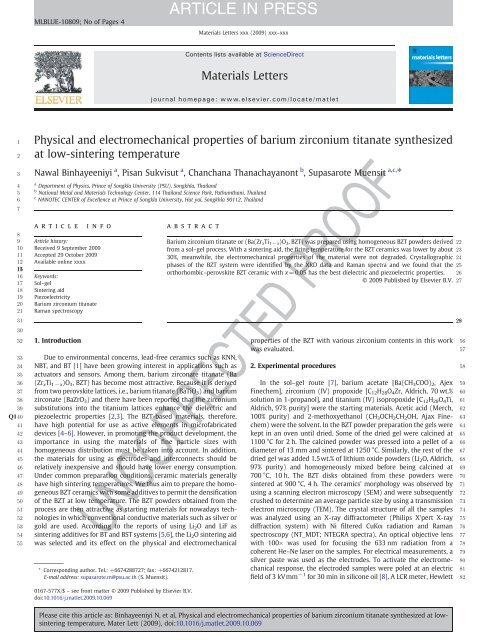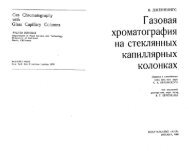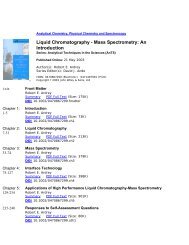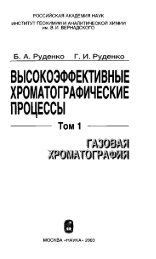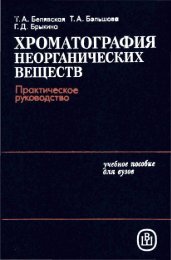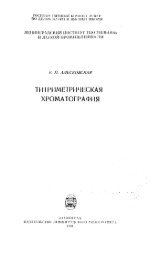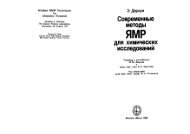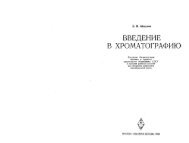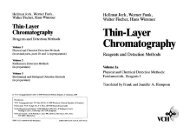Physical and electromechanical properties of barium zirconium ...
Physical and electromechanical properties of barium zirconium ...
Physical and electromechanical properties of barium zirconium ...
You also want an ePaper? Increase the reach of your titles
YUMPU automatically turns print PDFs into web optimized ePapers that Google loves.
MLBLUE-10809; No <strong>of</strong> Pages 4<br />
ARTICLE IN PRESS<br />
Materials Letters xxx (2009) xxx–xxx<br />
Contents lists available at ScienceDirect<br />
Materials Letters<br />
journal homepage: www.elsevier.com/locate/matlet<br />
1 <strong>Physical</strong> <strong>and</strong> <strong>electromechanical</strong> <strong>properties</strong> <strong>of</strong> <strong>barium</strong> <strong>zirconium</strong> titanate synthesized<br />
2 at low-sintering temperature<br />
3 Nawal Binhayeeniyi a , Pisan Sukvisut a , Chanchana Thanachayanont b , Supasarote Muensit a,c, ⁎<br />
4<br />
5<br />
6<br />
7<br />
a Department <strong>of</strong> Physics, Prince <strong>of</strong> Songkla University (PSU), Songkhla, Thail<strong>and</strong><br />
b National Metal <strong>and</strong> Materials Technology Center, 114 Thail<strong>and</strong> Science Park, Pathumthani, Thail<strong>and</strong><br />
c NANOTEC CENTER <strong>of</strong> Excellence at Prince <strong>of</strong> Songkla University, Hat yai, Songkhla 90112, Thail<strong>and</strong><br />
article info<br />
8<br />
9 Article history:<br />
10 Received 9 September 2009<br />
11 Accepted 29 October 2009<br />
12 Available online xxxx<br />
13 14 15<br />
16 Keywords:<br />
17 Sol–gel<br />
18 Sintering aid<br />
19 Piezoelectricity<br />
20 Barium <strong>zirconium</strong> titanate<br />
21 Raman spectroscopy<br />
31<br />
30<br />
32 1. Introduction<br />
abstract<br />
33 Due to environmental concerns, lead-free ceramics such as KNN,<br />
34 NBT, <strong>and</strong> BT [1] have been growing interest in applications such as<br />
35 actuators <strong>and</strong> sensors. Among them, <strong>barium</strong> zirconate titanate (Ba<br />
36 (Zr x Ti 1 − x )O 3 , BZT) has become most attractive. Because it is derived<br />
37 from two perovskite lattices, i.e., <strong>barium</strong> titanate (BaTiO 3 ) <strong>and</strong> <strong>barium</strong><br />
38 zirconate (BaZrO 3 ) <strong>and</strong> there have been reported that the <strong>zirconium</strong><br />
39 substitutions into the titanium lattices enhance the dielectric <strong>and</strong><br />
Q1 40 piezoelectric <strong>properties</strong> [2,3]. The BZT-based materials, therefore,<br />
41 have high potential for use as active elements in micr<strong>of</strong>abricated<br />
42 devices [4–6]. However, in promoting the product development, the<br />
43 importance in using the materials <strong>of</strong> fine particle sizes with<br />
44 homogeneous distribution must be taken into account. In addition,<br />
45 the materials for using as electrodes <strong>and</strong> interconnects should be<br />
46 relatively inexpensive <strong>and</strong> should have lower energy consumption.<br />
47 Under common preparation conditions, ceramic materials generally<br />
48 have high sintering temperatures. We thus aim to prepare the homo-<br />
49 geneous BZT ceramics with some additives to permit the densification<br />
50 <strong>of</strong> the BZT at low temperature. The BZT powders obtained from the<br />
51 process are then attractive as starting materials for nowadays tech-<br />
52 nologies in which conventional conductive materials such as silver or<br />
53 gold are used. According to the reports <strong>of</strong> using Li 2 O <strong>and</strong> LiF as<br />
54 sintering additives for BT <strong>and</strong> BST systems [5,6], the Li 2 O sintering aid<br />
55 was selected <strong>and</strong> its effect on the physical <strong>and</strong> <strong>electromechanical</strong><br />
Barium <strong>zirconium</strong> titanate or (Ba(Zr x Ti 1 − x )O 3 , BZT) was prepared using homogeneous BZT powders derived 22<br />
from a sol–gel process. With a sintering aid, the firing temperature for the BZT ceramics was lower by about 23<br />
30%, meanwhile, the <strong>electromechanical</strong> <strong>properties</strong> <strong>of</strong> the material were not degraded. Crystallographic 24<br />
phases <strong>of</strong> the BZT system were identified by the XRD data <strong>and</strong> Raman spectra <strong>and</strong> we found that the 25<br />
orthorhombic–perovskite BZT ceramic with x=0.05 has the best dielectric <strong>and</strong> piezoelectric <strong>properties</strong>. 26<br />
© 2009 Published by Elsevier B.V. 27<br />
<strong>properties</strong> <strong>of</strong> the BZT with various <strong>zirconium</strong> contents in this work<br />
was evaluated.<br />
2. Experimental procedures<br />
In the sol–gel route [7], <strong>barium</strong> acetate [Ba(CH 3 COO) 2 , Ajex<br />
Finechem], <strong>zirconium</strong> (IV) propoxide [C 12 H 28 O 4 Zr, Aldrich, 70 wt.%<br />
solution in 1-propanol], <strong>and</strong> titanium (IV) isopropoxide [C 12 H 28 O 4 Ti,<br />
Aldrich, 97% purity] were the starting materials. Acetic acid (Merch,<br />
100% purity) <strong>and</strong> 2-methoxyethanol (CH 3 OCH 2 CH 2 OH, Ajax Finechem)<br />
were the solvent. In the BZT powder preparation the gels were<br />
kept in an oven until dried. Some <strong>of</strong> the dried gel were calcined at<br />
1100 °C for 2 h. The calcined powder was pressed into a pellet <strong>of</strong> a<br />
diameter <strong>of</strong> 13 mm <strong>and</strong> sintered at 1250 °C. Similarly, the rest <strong>of</strong> the<br />
dried gel was added 1.5wt.% <strong>of</strong> lithium oxide powders (Li 2 O, Aldrich,<br />
97% purity) <strong>and</strong> homogeneously mixed before being calcined at<br />
700 °C, 10 h. The BZT disks obtained from these powders were<br />
sintered at 900 °C, 4 h. The ceramics' morphology was observed by<br />
using a scanning electron microscopy (SEM) <strong>and</strong> were subsequently<br />
crushed to determine an average particle size by using a transmission<br />
electron microscopy (TEM). The crystal structure <strong>of</strong> all the samples<br />
was analyzed using an X-ray diffractometer (Philips X'pert X-ray<br />
diffraction system) with Ni filtered CuKα radiation <strong>and</strong> Raman<br />
spectroscopy (NT_MDT; NTEGRA spectra). An optical objective lens<br />
with 100× was used for focusing the 633 nm radiation from a<br />
coherent He–Ne laser on the samples. For electrical measurements, a<br />
silver paste was used as the electrodes. To activate the <strong>electromechanical</strong><br />
response, the electroded samples were poled at an electric<br />
field <strong>of</strong> 3 kVmm − 1 for 30 min in silicone oil [8]. A LCR meter, Hewlett<br />
UNCORRECTED PROOF<br />
* Corresponding author. Tel.: +6674288727; fax: +6674212817.<br />
E-mail address: supasarote.m@psu.ac.th (S. Muensit).<br />
28 29<br />
56<br />
57<br />
58<br />
59<br />
60<br />
61<br />
62<br />
63<br />
64<br />
65<br />
66<br />
67<br />
68<br />
69<br />
70<br />
71<br />
72<br />
73<br />
74<br />
75<br />
76<br />
77<br />
78<br />
79<br />
80<br />
81<br />
82<br />
0167-577X/$ – see front matter © 2009 Published by Elsevier B.V.<br />
doi:10.1016/j.matlet.2009.10.069<br />
Please cite this article as: Binhayeeniyi N, et al, <strong>Physical</strong> <strong>and</strong> <strong>electromechanical</strong> <strong>properties</strong> <strong>of</strong> <strong>barium</strong> <strong>zirconium</strong> titanate synthesized at lowsintering<br />
temperature, Mater Lett (2009), doi:10.1016/j.matlet.2009.10.069
ARTICLE IN PRESS<br />
2 N. Binhayeeniyi et al. / Materials Letters xxx (2009) xxx–xxx<br />
Fig. 1. The XRD patterns <strong>of</strong> BZT powders calcined at 1100 °C, 2 h.<br />
83 Packard 4263B, was employed to observe the dielectric <strong>properties</strong>.<br />
84 The piezoelectric strain coefficient for the ceramic sample was deter-<br />
85 mined by the Piezo d 33 tester (APC Part number: 90-2030) [9]. A<br />
86 resonance method was used to determine the transverse piezoelectric<br />
87 coefficient [10].<br />
88 3. Results <strong>and</strong> discussion<br />
89 The XRD results <strong>of</strong> Ba(Zr x Ti 1 − x ,)O 3 ceramics display the polycrys-<br />
90 talline–perovskite phase at room temperature (Fig. 1). The BaCO 3<br />
91 (International Centre for Diffraction Data; ICDD No.01-071-2394) was<br />
92 observed <strong>and</strong> disappeared at high calcination temperature. The crys-<br />
93 tallographic phase <strong>of</strong> the BaTiO 3 is tetragonal (ICDD No.01-075-0462)<br />
94 <strong>and</strong> it is cubic for the Ba(Zr 0.20 Ti 0.80 )O 3 (ICDD No.00-006-0399).<br />
For the BZT samples with small increment <strong>of</strong> <strong>zirconium</strong> content, i.e.,<br />
0.00bxb0.02, it was not possible to identify the crystalline phase due to<br />
the close proximity <strong>of</strong> the diffraction angles. Their phases were further<br />
observed from the Raman spectrum at room temperature (Fig. 2). Due to<br />
the r<strong>and</strong>om grain orientation <strong>of</strong> the BZT powders the direction <strong>of</strong> the<br />
phonon wave vectors is r<strong>and</strong>om from one grain to the others with respect<br />
to the crystallographic axes [11,12]. The Raman line <strong>of</strong> the powders<br />
shows a mixing mode. When the titanium ions were replaced by the<br />
<strong>zirconium</strong> ions more than 10wt.%, the Raman mode <strong>of</strong> ~125 cm −1 was<br />
absent. When the Zr content reached 10 mol%, the frequency mode was<br />
at about 130 cm −1 . This is because the ionic radius <strong>of</strong> the Zr 4+ ions is<br />
larger than that <strong>of</strong> the Ti 4+ ions, it indicated that the phase transforms<br />
from orthorhombic to rhombohedral [11]. The results also show that<br />
there have no changes in crystal structures relating to the LiO 2 because<br />
there is no shift in the Raman line (Fig. 2 a <strong>and</strong> b). The absence <strong>of</strong> the<br />
180 cm −1 A 1 (TO 1 ) mode in Ba(Zr 0.20 Ti 0.80 )O 3 was due to the cubic nature<br />
<strong>of</strong> the BZT with x=0.20 [12].<br />
The SEM images <strong>of</strong> the BZT ceramics with various compositions<br />
were shown in Fig. 3 <strong>and</strong> a summary <strong>of</strong> the physical <strong>properties</strong> was in<br />
Table 1. Without sintering aid the grain size <strong>of</strong> BZT ceramic was rather<br />
cubic <strong>and</strong> significantly decreased when the Li 2 O was added. However,<br />
the ceramic texture was denser with higher density as observed in the<br />
Ba(Zr 0.05 Ti 0.95 )O 3 sample.<br />
The temperature dependence <strong>of</strong> the dielectric constant was observed<br />
in the BZT without <strong>and</strong> with sintering aid (Fig. 4). The transition<br />
temperatures in the samples with 0.0bxb0.2 were above room<br />
temperature <strong>and</strong> became closer as the unit cell changed toward the<br />
cubic structure. At room temperature, the dielectric constant <strong>and</strong><br />
the loss tangent increased with Zr content. The Zr substitutions lead<br />
to a small expansion <strong>of</strong> the unit cell <strong>and</strong> thus an increase in net<br />
polarization. The Ba(Zr 0.05 Ti 0.95 )O 3 is good thermally stable <strong>and</strong> its<br />
transition temperature slightly higher after doping. The diffusions <strong>of</strong><br />
Li + ions did not significantly affect the transition because <strong>of</strong> a small<br />
amount <strong>of</strong> Li 2 O. As noticed earlier, there was a large reduction in grain<br />
UNCORRECTED PROOF<br />
95<br />
96<br />
97<br />
98<br />
99<br />
100<br />
101<br />
102<br />
103<br />
104<br />
105<br />
106<br />
107<br />
108<br />
109<br />
110<br />
111<br />
112<br />
113<br />
114<br />
115<br />
116<br />
117<br />
118<br />
119<br />
120<br />
121<br />
122<br />
123<br />
124<br />
125<br />
126<br />
127<br />
128<br />
Q2 Fig. 2. The Raman spectra <strong>of</strong> (a, c–e) Ba(Zr x Ti 1 − x )O 3 powders calcined at 1100 °C, 2 h <strong>and</strong> (b) Ba(Zr 0.05 Ti 0.95 )O 3 powders with 1.5wt.% Li 2 O calcined at 700 °C, 10 h.<br />
Please cite this article as: Binhayeeniyi N, et al, <strong>Physical</strong> <strong>and</strong> <strong>electromechanical</strong> <strong>properties</strong> <strong>of</strong> <strong>barium</strong> <strong>zirconium</strong> titanate synthesized at lowsintering<br />
temperature, Mater Lett (2009), doi:10.1016/j.matlet.2009.10.069
ARTICLE IN PRESS<br />
N. Binhayeeniyi et al. / Materials Letters xxx (2009) xxx–xxx<br />
3<br />
129 size in Li-doped sample <strong>and</strong> this leads to a wider dielectric curve with<br />
130 a lower dielectric constant which, however, remains relatively high<br />
131 when compared to conventional ceramics. This material is, thus,<br />
132 promising for use in various applications.<br />
t1:1 Table 1<br />
Mean particle size, d <strong>of</strong> the BZT powders <strong>and</strong> density <strong>and</strong> average grain size <strong>of</strong> the BZT<br />
ceramics.<br />
t1:2<br />
t1:3 Ba(Zr x Ti 1 − x )O 3 powders S w<br />
(m 2 /g)<br />
d<br />
(μm)<br />
Density<br />
(g/cm 3 )<br />
Average grain size<br />
(μm)<br />
t1:4 x=0.00 2.14 0.46 5.04 39.60<br />
t1:5 x=0.05 3.45 0.28 5.06 27.54<br />
t1:6 x=0.05 +1.5 wt.% Li 2 O 1.66 0.13 5.59 4.00<br />
t1:7 x=0.10 3.19 0.29 5.09 21.63<br />
t1:8 x=0.15 3.49 0.28 5.38 20.19<br />
t1:9 x=0.20 3.92 0.25 5.41 15.94<br />
Fig. 3. SEM images for Ba(Zr x Ti 1 − x )O 3 ceramics.<br />
The <strong>electromechanical</strong> <strong>properties</strong> for all the samples were summarized<br />
in Table 2. The dielectric constant <strong>of</strong> the low-sinteringtemperature<br />
Ba(Zr 0.05 Ti 0.95 )O 3 was slightly decreased. The dielectric<br />
loss was also lower. The sample at this composition exhibits the<br />
relatively high piezoelectric response <strong>and</strong> good <strong>electromechanical</strong><br />
coupling. It is known that the higher the number <strong>of</strong> polarizable<br />
directions aligned to a poling field, the larger the piezoelectric coefficient<br />
is. Possible polar directions in the tetragonal, orthorhombic,<br />
<strong>and</strong> rhombohedral structures are six, twelve, <strong>and</strong> eight, respectively.<br />
This corresponded to the crystalline phases identified earlier that the<br />
Ba(Zr 0.05 Ti 0.95 )O 3 is orthorhombic while the Ba(Zr 0.10 Ti 0.90 )O 3 <strong>and</strong> Ba<br />
(Zr 0.15 Ti 0.85 )O 3 are rhombohedral.<br />
4. Conclusions<br />
Barium zirconate titanate <strong>of</strong> different Zr contents was studied their<br />
physical <strong>and</strong> <strong>electromechanical</strong> <strong>properties</strong> <strong>and</strong> the use <strong>of</strong> lithium<br />
oxide as sintering aid was evaluated. With the additive, the densification<br />
<strong>of</strong> the BZT took place at 900 °C which is lower than the<br />
melting points <strong>of</strong> the conventional conductive materials like silver<br />
<strong>and</strong> gold. The effect <strong>of</strong> sintering aid on the physical <strong>properties</strong> was<br />
UNCORRECTED PROOF<br />
Fig. 4. Temperature dependence <strong>of</strong> the dielectric constant for BZT samples.<br />
Table 2 t2:1<br />
Room-temperature <strong>electromechanical</strong> <strong>properties</strong> <strong>of</strong> the BZT ceramics.<br />
Ba(Zr x Ti 1 − x )O 3 d 33<br />
coefficient<br />
(pC N − 1 )<br />
d 31<br />
coefficient<br />
(pC N − 1 )<br />
k p<br />
(%)<br />
Dielectric<br />
constant<br />
(1 kHz)<br />
Dielectric<br />
loss<br />
(1 kHz)<br />
x=0.00 101 ±5.0 −25.65 46 1302 0.037<br />
x=0.05 126 ±5.0 −23.95 44 1361 0.041<br />
x=0.05 +1.5wt.% Li 2 O 120 ±5.0 −22.25 44 1250 0.026<br />
x=0.10 83±5.0 −24.56 44 1957 0.045<br />
x=0.15 36±5.0 −19.27 44 3704 0.060<br />
x=0.20 – – – 5118 0.070<br />
133<br />
134<br />
135<br />
136<br />
137<br />
138<br />
139<br />
140<br />
141<br />
142<br />
143<br />
144<br />
145<br />
146<br />
147<br />
148<br />
149<br />
150<br />
151<br />
t2:2<br />
t2:3<br />
t2:4<br />
t2:5<br />
t2:6<br />
t2:7<br />
t2:8<br />
t2:9<br />
Please cite this article as: Binhayeeniyi N, et al, <strong>Physical</strong> <strong>and</strong> <strong>electromechanical</strong> <strong>properties</strong> <strong>of</strong> <strong>barium</strong> <strong>zirconium</strong> titanate synthesized at lowsintering<br />
temperature, Mater Lett (2009), doi:10.1016/j.matlet.2009.10.069
ARTICLE IN PRESS<br />
4 N. Binhayeeniyi et al. / Materials Letters xxx (2009) xxx–xxx<br />
152 observed in the low-sintering-temperature BZT, however, their good<br />
153 <strong>electromechanical</strong> <strong>properties</strong> remained. Mechanically activated pow-<br />
154 ders <strong>of</strong> this material are attractive for, e.g., making paste materials<br />
155 used in conventional screen-printing techniques [4].<br />
156 Acknowledgements<br />
157 The authors thank the Office <strong>of</strong> the Higher Education Commission,<br />
158 Thail<strong>and</strong> for the grant support under the program Strategic Scholar-<br />
159 ships for Frontier Research Network for the Join Ph.D. Program <strong>of</strong> Thai<br />
160 Doctoral Degree <strong>and</strong> the National Nanotechnology Center (NANOTEC),<br />
161 NSTDA, Ministry <strong>of</strong> Science <strong>and</strong> Technology, through its program <strong>of</strong><br />
162 Center <strong>of</strong> Excellence Network at PSU.<br />
178<br />
References<br />
[1] Shrout RT, Zhang SJ. J Electroceram 2007;19:111.<br />
[2] Yu Z, Ang C, Gua R, Bhalla AS. J Appl Phys 2002;92:1489.<br />
[3] Yu Z, Ang C, Gua R, Bhalla AS. Mater Lett 2007;61:326.<br />
[4] Ginet P, Lucat C, Ménil F. Int J Appl Technol 2007;4(5):423.<br />
[5] Stojanovic BD, Foschini CR, Pavlovic VB, Pavlovic VM, Pejovic V, Varela JAV. Ceram<br />
Int 2002;28:293.<br />
[6] Tick T, Peränti J, Jantunen H, Usimäki AU. J Eur Ceram Soc 2008;28:837.<br />
[7] Jiwei Z, Yao X, Zhang L, Shen B, Haydn C. J Cryst Growth 2004;262:341.<br />
[8] Jeong SJ, Lee DS, Park EC, Song JS. J Electrocerm 2006;17:537.<br />
[9] Berlincourt Piezo d 33 meter manual. (1974).<br />
[10] Mason WP, Jaffe H. Proc IRE 1954;42:921.<br />
[11] Moura F, Simões AZ, Stojanavic BD, Zaghete MA, Longo E, Varela JA. J Alloy <strong>and</strong><br />
Compound 2008;462:129.<br />
[12] Dobal PS, Dixit A, Katiyar RS, Yu Z, Gua R, Bhalla RS. J Appl Phys 2001;89:8085.<br />
UNCORRECTED PROOF<br />
163<br />
164<br />
165<br />
166<br />
167<br />
168<br />
169<br />
170<br />
171<br />
172<br />
173<br />
174<br />
175<br />
176<br />
177<br />
Please cite this article as: Binhayeeniyi N, et al, <strong>Physical</strong> <strong>and</strong> <strong>electromechanical</strong> <strong>properties</strong> <strong>of</strong> <strong>barium</strong> <strong>zirconium</strong> titanate synthesized at lowsintering<br />
temperature, Mater Lett (2009), doi:10.1016/j.matlet.2009.10.069


